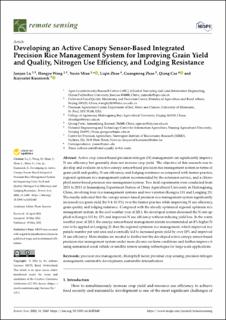| dc.contributor.author | Lu, Junjun | |
| dc.contributor.author | Wang, Hongye | |
| dc.contributor.author | Miao, Yuxin | |
| dc.contributor.author | Zhao, Liqin | |
| dc.contributor.author | Zhao, Guangming | |
| dc.contributor.author | Cao, Qiang | |
| dc.contributor.author | Kusnierek, Krzysztof | |
| dc.date.accessioned | 2022-10-12T07:56:21Z | |
| dc.date.available | 2022-10-12T07:56:21Z | |
| dc.date.created | 2022-09-08T10:10:21Z | |
| dc.date.issued | 2022-05-19 | |
| dc.identifier.citation | Remote Sensing. 2022, 14 (10), 1-24. | en_US |
| dc.identifier.issn | 2072-4292 | |
| dc.identifier.uri | https://hdl.handle.net/11250/3025485 | |
| dc.description.abstract | Active crop sensor-based precision nitrogen (N) management can significantly improve N use efficiency but generally does not increase crop yield. The objective of this research was to develop and evaluate an active canopy sensor-based precision rice management system in terms of grain yield and quality, N use efficiency, and lodging resistance as compared with farmer practice, regional optimum rice management system recommended by the extension service, and a chlorophyll meter-based precision rice management system. Two field experiments were conducted from 2011 to 2013 at Jiansanjiang Experiment Station of China Agricultural University in Heilongjiang, China, involving four rice management systems and two varieties (Kongyu 131 and Longjing 21). The results indicated that the canopy sensor-based precision rice management system significantly increased rice grain yield (by 9.4–13.5%) over the farmer practice while improving N use efficiency, grain quality, and lodging resistance. Compared with the already optimized regional optimum rice management system, in the cool weather year of 2011, the developed system decreased the N rate applied in Kongyu 131 by 12% and improved N use efficiency without inducing yield loss. In the warm weather year of 2013, the canopy sensor-based management system recommended an 8% higher N rate to be applied in Longjing 21 than the regional optimum rice management, which improved rice panicle number per unit area and eventually led to increased grain yield by over 10% and improved N use efficiency. More studies are needed to further test the developed active canopy sensor-based precision rice management system under more diverse on-farm conditions and further improve it using unmanned aerial vehicle or satellite remote sensing technologies for large-scale applications. | en_US |
| dc.language.iso | eng | en_US |
| dc.publisher | MDPI | en_US |
| dc.rights | Navngivelse 4.0 Internasjonal | * |
| dc.rights.uri | http://creativecommons.org/licenses/by/4.0/deed.no | * |
| dc.title | Developing an Active Canopy Sensor-Based Integrated Precision Rice Management System for Improving Grain Yield and Quality, Nitrogen Use Efficiency, and Lodging Resistance | en_US |
| dc.title.alternative | Developing an Active Canopy Sensor-Based Integrated Precision Rice Management System for Improving Grain Yield and Quality, Nitrogen Use Efficiency, and Lodging Resistance | en_US |
| dc.type | Peer reviewed | en_US |
| dc.type | Journal article | en_US |
| dc.description.version | publishedVersion | en_US |
| dc.rights.holder | © 2022 by the authors | en_US |
| dc.source.pagenumber | 1-24 | en_US |
| dc.source.volume | 14 | en_US |
| dc.source.journal | Remote Sensing | en_US |
| dc.source.issue | 10 | en_US |
| dc.identifier.doi | 10.3390/rs14102440 | |
| dc.identifier.cristin | 2049804 | |
| dc.source.articlenumber | 2440 | en_US |
| cristin.ispublished | true | |
| cristin.fulltext | original | |
| cristin.qualitycode | 1 | |

